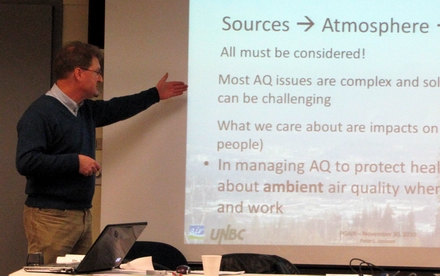Industry, Road Dust and Trains Top Three Sources for PM2.5
By 250 News
Tuesday, November 30, 2010 10:06 PM

Dr.Peter Jackson details the results of the report in a presentation to the PG AIR Annual General Meeting.
Prince George, B.C.- The final report on the four year study of Prince George Air Quality indicates the top four contributors to PM2.5 at the Plaza 400 site downtown are:
1. Permitted users (industry 18%)
2. On road dust (mobile sources, 15%)
3. Locomotive sources 12% and
4. Commercial restaurants 11%.
The report indicates the results for restaurants seem to be unusually high, so that will be revisited. Residential heating accounted for 8%.
These results differ from the study released in 2007 which used a different method to track pollutants. That report listed the top three offenders as:
· pulp emissions
· wood-burning emissions
· mobile (including vehicle) emissions
The new report also suggests the PG Air Improvement Roundtable, may want to take another look at its goals. The target set by PG AIR is to reduce PM 2.5 annual concentrations to the annual 5ug/m3 by 2016. The study says all major source categories would have to have a 75% reduction in order to reach that target. It suggests perhaps a 65% reduction is more realistic.
Report Co -author, Peter Jackson, says the science may not be perfect, but the numbers in the new study are the best they have to work with.
The report helped form the draft plan for Phase Three of the Prince George Air Quality Management Plan. That draft carries 47 recommendations for action in five sectors, Industry, commercial, transportation, residential and research & education.
The draft plan will be up for public consultation and input at a special session set for December 8th at 6 p.m. in room 208 at the Civic Centre.
Some of the recommendations include:
Industry:
-review and implement operational procedures to reduce emissions
- new industry in the community to locate in suitable areas
-Continuous improvement of regulatory protocols for permitted facilities
Commercial:
-reduce emissions from space and comfort heaters,
-Reduce idling at drive- thrus
-Reduce PM emissions from commercial restaurants
Transportation:
-Reduce road dust thru improved City street sweeping practices
-Encourage winter tire use to reduce quantities of road aggregate needed
-Education strategy to reduce vehicle idling
-Improve transportation infrastructure that results in decreased emissions
-Encourage alternative transportation
Residential:
-reduce emissions from recreational vehicles which create fugitive dust
-reduce residential emissions from improper use or burning of the following:
Open burning, BBQ-ing, food smoking, recreation fires,
Research, Education Other:
-hire clean air ambassador
-hire air quality coordinator
Previous Story - Next Story
Return to Home









